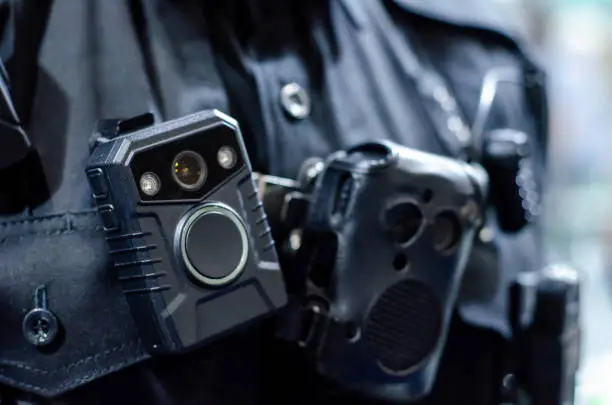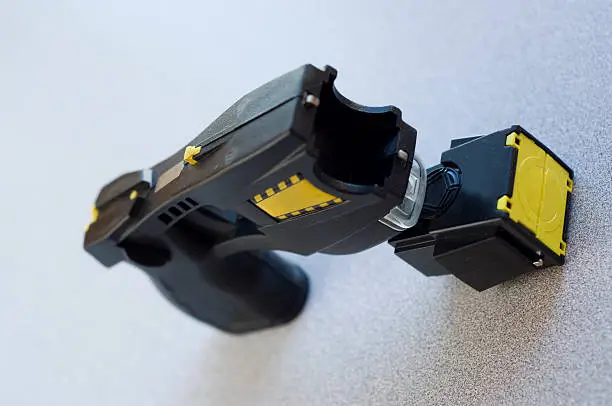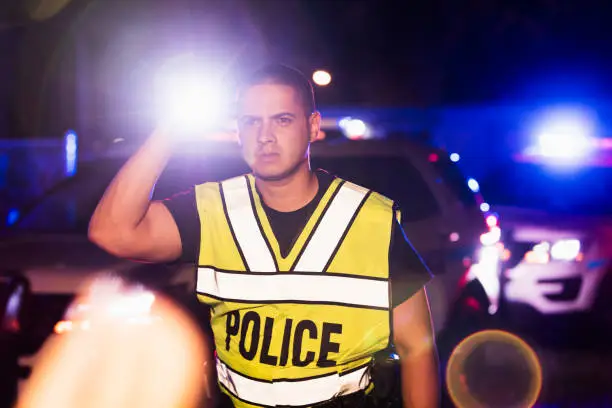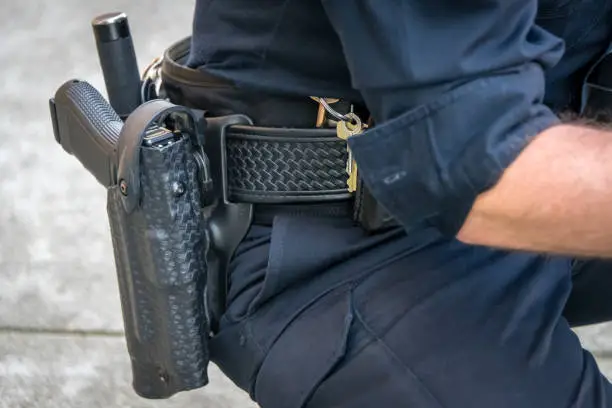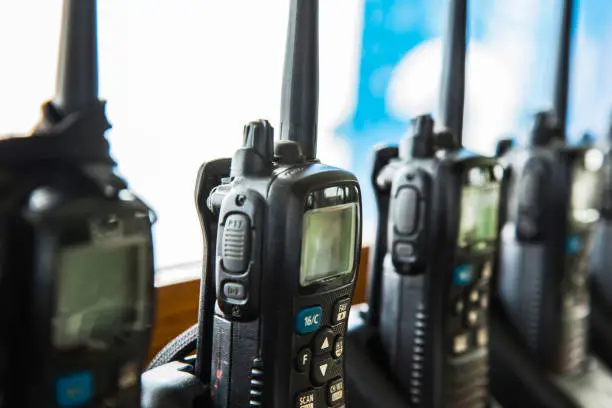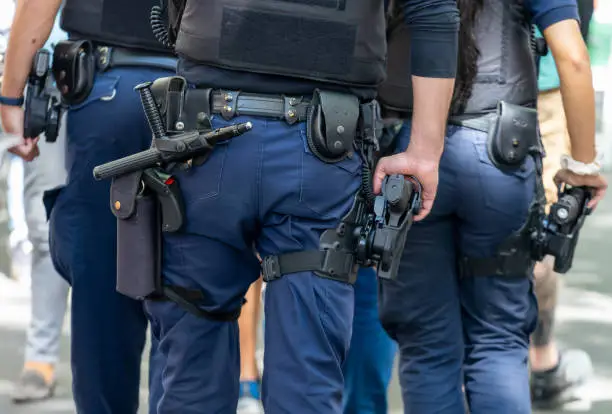
The 1970's would see a transformation in police mobility; radio communications; response times, and administrative and crime reporting processes.
Barry M. Baker Tweet

Detective Lieutenant Barry M. Baker (ret.) is a 32 year veteran of the Baltimore Police Department.
Police gear for a Baltimore police officer circa 1965 consisted of a Colt .38 caliber revolver, an espantoon (nightstick) and handcuffs. Individual foot patrol officers formed the bulk of Baltimore’s patrol force. When an officer made an arrest, he’d have to walk his prisoner to the nearest call box to call for the paddy wagon.
In 1966, all this began to change. Donald D. Pomerleau became Baltimore’s Police Commissioner, and he embarked on a modernization process. By 1971 when I joined the department, Baltimore was at the forefront of modern policing. The patrol force was entirely motorized, and the few foot officers remaining were equiped with portable radios (walkie-talkies).
- Police Gear - (ads)
The Evolution of Police Gear and Technolgy
Police gear and technology cannot be separated, because the gear cannot develop and improve without technological advancements. Commissioner Pomerleau warned early on that his modernization process would result in a massive increase in crime. The result would not occur from actual crime; instead, the result would come from accurate reporting of crime.
In 1965, the Baltimore patrolman would carry a folded FORM 95 inside his hat. On occasion when the officer decided to write a report, he would tell the story on the all-purpose form. This was the state of Baltimore’s crime reporting system. The modernization would create a sophisticated crime reporting system, and it would validate Pomerleau’s prediction.
- Police Gear - (ads)
The Pace of Evolution
The 1970’s would see a transformation in police mobility; radio communications; response times, and administrative and crime reporting processes. Elsewhere, the basic tools of the job didn’t move much beyond the gun; nightstick, and handcuffs. A cannister of chemical mace was added to the gun belt, but it’s usefulness was often up for debate.
The 1980’s would see a significant advancement in police gear. The bullet proof vest was a goal for decades, but the proper materials and weight precluded comfort for continuous use. Kevlar, a fabric developed in 1965, would come of age, and it would make the bullet proof vest a reality.
Secure holster technology began in the 1980’s, and individual officers could invest in the products. Police departments began issuing secure holsters by the end of the decade when revolvers were replaced by high ammunition capacity pistols. These two events could arguably be the most important advancements in police gear.
- Police Gear - (ads)
The Indispensable Ballpoint Pen
Computer technology has been a boon to report writing, but it hasn’t ended the importance of the ballpoint pen. The pen is the one piece of police gear that you’ll use every day of your career. I’ve worked with police officers who abhored putting anything to paper, but even they could not get through a single shift without their ballpoint pens.
Police Gear - Ballpoint Pens (ads)
Apparel
You’ll begin your police career as a patrol officer, and everybody in patrol is supposed to be attired uniformly. I say supposed, because that’s how it was when I started. Individuality is a hard thing to suppress, and police officers rarely respond to suppression. You’ll probably get away with a little bit of modification as long as you don’t go to extremes. It all depends on your police department’s policies.
Police Gear - Apparel (ads)
Body Worn Camera (BWC)
The body worn camera has adapted well to most police departments, but a new frontier is here. It’s called artificial intelligence, and it is transforming the way police reports are written. Axon, Inc. and other companies have developed AI to generate written police reports from the bodycam’s audio. There are critics, mostly defense lawyers, saying the AI will sacrifice accuracy. This is odd since defense lawyers thrive on police officers’ inaccuracies.
Police Gear - Body Worn Camera (ads)
Less than Lethal Police Gear
The nightstick served for decades as the police officer’s primary instrument for the application of less than lethal force. Today, you are afforded a variety of defensive weapons to preclude the use of blunt force, and the escalation to deadly force. The Taser is the most well known and widely employed less than lethal weapon. The Taser can be fired from a distance, or it can be pressed directly against a suspect’s body. It delivers a 50,000 volt electrical shock that will, in most instances, incapacitate a violent suspect.
Police Gear - Less than Lethal (ads)
Chemical Agents
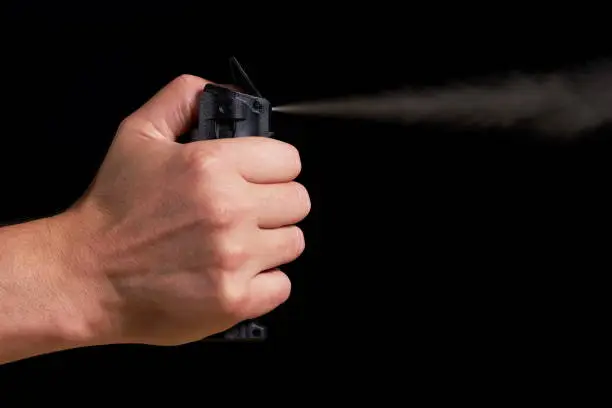
There are four major types of chemical agents use by law enforcement, and you’ll be most familiar with pepper spray. Pepper spray is in the tear gas category, and it contains the active compound capsaicin derived from chili peppers. When properly delivered, it will irritate the eyes and mucous membranes causing burning pain and temporary blindness. Just be careful when engaging, because it can have the same effect on you.
Police Gear - Chemical Agents (ads)
Overview of Chemical Agents: This brief overview provides an excellent description of the four major types of agents.
Police Batons
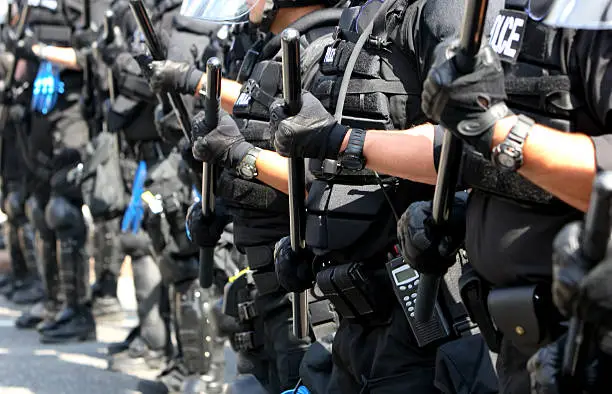
The police baton is a defensive weapon, and you should always carry it on your belt. It will never be of any use if it’s out of your reach. Baton is a term that applies to weapons made from wood, plastic or metal, and they come in various sizes. A baton has many uses, but here’s an important point. Never strike a person above the shoulders with your baton; unless, the situation requires your use of deadly force.
Police Gear - Batons (ads)
Police Handcuffs

Handcuffs are an essential piece of police gear, and you’ll use them often. They are simple to use; unless, the person being handcuffed doesn’t want to be handcuffed. I worked with an officer who had mastered the art of affixing handcuffs. He was so fast that the suspect was cuffed, before the suspect could decide to resist.
Police Gear - Handcuffs (ads)
Flashlights Command the Darkness
The flashlight is an obvious item of police gear, but it is often not readily available when needed. Of course, today’s police officers always have their iPhones within reach to provide emergency lighting.
Still, it’s a good idea to invest in a high quality flashlight, and the brighter, the better.
Police Gear - Flashlights (ads)
Modern Holster Technology is Impressive
When I began my career, holster technology was pretty primitive. The swivel holsters of the time were not known for security. I was the first officer to arrive at the scene of a street shooting. I exited my car, and I felt my revolver falling from the holster. The gun hit the pavement, and it slid beneath the car. I was lucky, it only travelled a few inches, and I quickly retrieved the gun. The safety issue was critical, but the embarrassment was brutal.
Police Gear - Holsters (ads)
Police Communications Gear
Today’s active police officers have never experienced life without a mobile device. The only communication devices police officers once had were a whistle and a nightstick. The whistle is obvious, but what about the nightstick? The nightstick was banged against the curb, and the unique alarm could bring the foot officer from the adjoining post.
Police Gear - Police Radios (ads)
Firearms Police Gear
This may not be a comforting thought to contemplate, but if you ever have to use your service pistol, it will probably be a sudden, up front and personal confrontation. There is a good part to this. If you’re one of the poor marksmen, the normal skills required for qualification won’t be that critical.
Police Gear - Firearms (ads)
Body Armor Police Gear
Baltimore was one of the first major police departments to issue soft body armor in the 1980s. The vest consisted of a single Kevlar panel for the front only, and it was rated as a level I or type I. This rating prevented penetration by .22 caliber; .25 caliber; .32 caliber, and .380 caliber bullets.
Police Gear - Body Armor (ads)
Ballistic Shields Police Gear
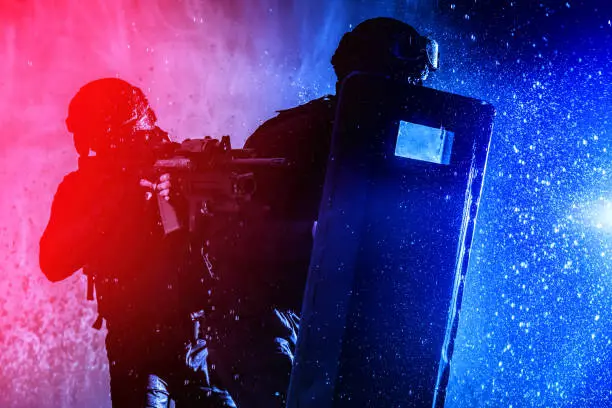
Body armor is designed for the unexpected ballistic threat while ballistic shields exist to counter the expected. Shields come in all shapes and sizes from handheld shields to bunkers on wheels. A military organization conducts missions factoring in acceptable casualty rates. A police department is different – the accepted casualty rate is ZERO.
Police Gear - Ballistic Shields (ads)
Robotics Police Gear
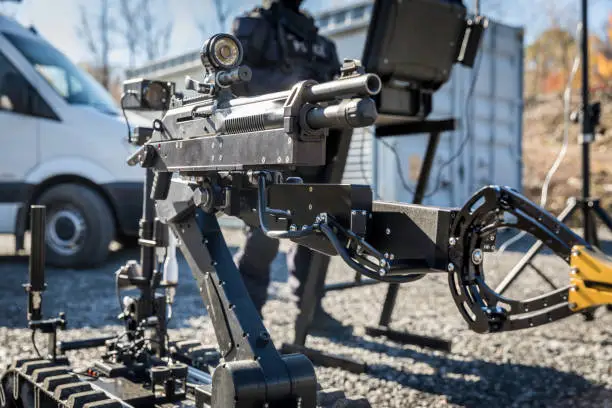
Dallas, TX 2016. A sniper shot and killed five Dallas police officers. He was firing from the second floor of El Centro Community College building in downtown Dallas. A 45 minute gun battle ensued, and attempts to negotiate failed. Police fitted a pound of C4 explosive to a bomb disposal robot, and the explosive was set against a brick wall adjacent to the suspect. This was the first known instance of a police robot used to deliver deadly force.
Police Gear - Robotics (ads)
Police Drone Technology
The sky is the limit – so to speak.
Camera drones are fascinating, and their affordability makes them available to individuals as well as any police department. I wouldn’t recommend individual officers working in urban settings to operate your own drone, but rural areas could be different. In either instance, your police department would have to approve any use of a drone.
Police Gear - Drones (ads)
Police Cars
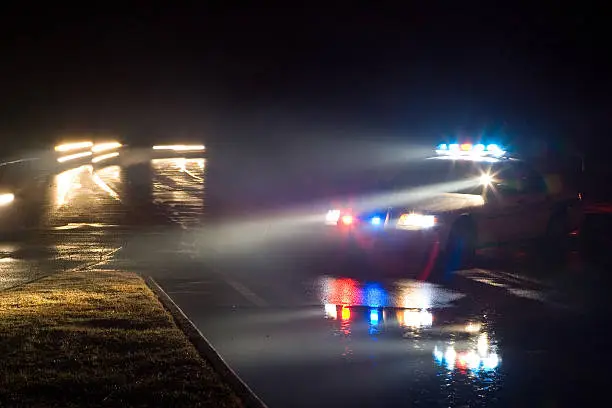
Your police car is your biggest and most expensive piece of police gear, and it will be the most problematic. Many things can get a police officer into trouble, and the police car is near the top of that list. Care and maintenance are obvious concerns, but safety issues for you and the public are paramount. Lights and sirens are cool, but they don’t always prevent disasters. There are more police officer line-of-duty deaths from traffic accidents than from any other cause.
Police Gear - Police Cars (ads)
Related Content for Police Gear
Police Sergeant, E-Commerce Owner, Author
Welcome! The Notebook Files is a Law Enforcement Blog that takes you into todays trending police topics, how to guides, the hottest equipment reviews and gear buyer guides.
Advertisements



